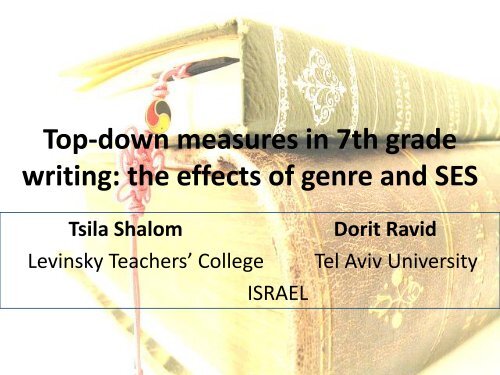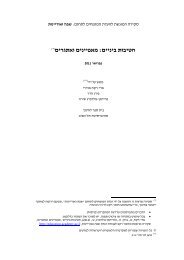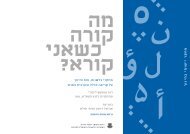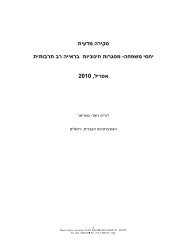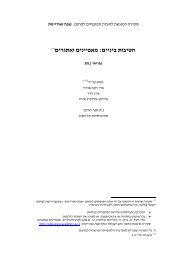Top-down measures in 7th grade writing: the effects of genre and SES
Top-down measures in 7th grade writing: the effects of genre and SES
Top-down measures in 7th grade writing: the effects of genre and SES
Create successful ePaper yourself
Turn your PDF publications into a flip-book with our unique Google optimized e-Paper software.
<strong>Top</strong>-<strong>down</strong> <strong>measures</strong> <strong>in</strong> <strong>7th</strong> <strong>grade</strong><br />
writ<strong>in</strong>g: <strong>the</strong> <strong>effects</strong> <strong>of</strong> <strong>genre</strong> <strong>and</strong> <strong>SES</strong><br />
Tsila Shalom<br />
Lev<strong>in</strong>sky Teachers’ College<br />
ISRAEL<br />
Dorit Ravid<br />
Tel Aviv University
The St<strong>and</strong>ards Project<br />
• Funded by Yad Hanadiv (Rothschild) Foundation<br />
<strong>in</strong> Israel<br />
• In collaboration with<br />
– CET (Center for Educational Technology)<br />
– Tel Aviv University School <strong>of</strong> Education<br />
2
Research team at <strong>the</strong> St<strong>and</strong>ards Project<br />
• Elitzur Dattner<br />
• Irit Katzenberger<br />
• Guy Sha’ashua<br />
3
Writ<strong>in</strong>g as <strong>the</strong> Hallmark <strong>of</strong> Literacy<br />
• L<strong>in</strong>guistic Literacy (Berman & Ravid, 2008; Ravid,<br />
2012; Ravid & Tolch<strong>in</strong>sky, 2002)<br />
– Ready <strong>and</strong> <strong>in</strong>formed access to an encyclopedic<br />
range <strong>of</strong> language uses rang<strong>in</strong>g across different<br />
discourse <strong>genre</strong>s <strong>in</strong> speech <strong>and</strong> writ<strong>in</strong>g, framed <strong>in</strong><br />
registers <strong>of</strong> use <strong>and</strong> geared towards appropriate<br />
communicative functions<br />
4
Written texts<br />
• The core <strong>of</strong> literate language, requir<strong>in</strong>g <strong>the</strong> ability<br />
to control <strong>and</strong> shape <strong>the</strong> flow <strong>of</strong> content <strong>and</strong><br />
<strong>in</strong>formation <strong>in</strong> discourse through l<strong>in</strong>guistic<br />
means, while view<strong>in</strong>g <strong>the</strong> written text as an<br />
autonomous, whole entity<br />
• Th<strong>in</strong>k<strong>in</strong>g for writ<strong>in</strong>g (Slob<strong>in</strong>, 2003)<br />
Slob<strong>in</strong>, D.I. 2003. Language <strong>and</strong> thought onl<strong>in</strong>e: Cognitive consequences <strong>of</strong><br />
l<strong>in</strong>guistic relativity. In D. Gentner & S. Gold<strong>in</strong>-Meadow (Eds.), Language <strong>in</strong><br />
m<strong>in</strong>d: Advances <strong>in</strong> <strong>the</strong> study <strong>of</strong> language <strong>and</strong> thought (pp. 157-192).<br />
Cambridge, MA: MIT Press.<br />
5
7 th <strong>grade</strong>rs (12-13 year olds)<br />
• Poised to take <strong>of</strong>f <strong>in</strong>to adolescence, a time<br />
when many <strong>of</strong> <strong>the</strong> cognitive, social, <strong>and</strong><br />
l<strong>in</strong>guistic abilities necessary to produce<br />
written texts will be at <strong>the</strong>ir disposal<br />
• The advent <strong>of</strong> powerful (meta)memory <strong>and</strong><br />
executive functions, coupled with <strong>in</strong>creas<strong>in</strong>g<br />
underst<strong>and</strong><strong>in</strong>g <strong>of</strong> how people <strong>and</strong> th<strong>in</strong>gs<br />
operate <strong>and</strong> <strong>the</strong> vocabulary <strong>and</strong> grammar<br />
necessary to express <strong>the</strong>se relationships<br />
6
Writ<strong>in</strong>g<br />
• Requires <strong>the</strong> active mediation <strong>and</strong> support <strong>of</strong><br />
teachers<br />
• Construct<strong>in</strong>g a piece <strong>of</strong> written language imposes<br />
heavy dem<strong>and</strong>s on both bottom-up <strong>and</strong> top<strong>down</strong><br />
process<strong>in</strong>g abilities<br />
– retriev<strong>in</strong>g <strong>the</strong> specific words for <strong>the</strong> desired<br />
expression <strong>of</strong> content, comb<strong>in</strong><strong>in</strong>g <strong>the</strong>m <strong>the</strong><br />
appropriate syntactic <strong>and</strong> rhetorical structures, <strong>and</strong><br />
<strong>in</strong>tegrat<strong>in</strong>g <strong>the</strong>m smoothly <strong>and</strong> mean<strong>in</strong>gfully <strong>in</strong> view<br />
<strong>of</strong> <strong>the</strong> overall goal <strong>of</strong> <strong>the</strong> text under construction<br />
7
St<strong>and</strong>ards<br />
• St<strong>and</strong>ards are published documents that<br />
establish specifications <strong>and</strong> procedures designed<br />
to ensure <strong>the</strong> reliability <strong>of</strong> <strong>the</strong> materials,<br />
products, methods, <strong>and</strong>/or services people use<br />
every day<br />
• St<strong>and</strong>ards address a range <strong>of</strong> issues, <strong>in</strong>clud<strong>in</strong>g but<br />
not limited to various protocols to help ensure<br />
product functionality <strong>and</strong> compatibility, facilitate<br />
<strong>in</strong>teroperability <strong>and</strong> support consumer safety <strong>and</strong><br />
public health<br />
8
The problem <strong>in</strong> Israel<br />
• No common , accessible knowledge base that will<br />
enable teachers assess <strong>the</strong> quality <strong>of</strong> students’<br />
writ<strong>in</strong>g<br />
• In <strong>the</strong> absence <strong>of</strong> systematic, evidence-based<br />
st<strong>and</strong>ards, everybody makes up <strong>the</strong>ir own local<br />
assessment <strong>of</strong> students’ texts with different<br />
considerations <strong>and</strong> preconceptions<br />
• No real idea what to expect at each age level <strong>and</strong><br />
from different <strong>genre</strong>s<br />
• Great variability, no reliability<br />
9
St<strong>and</strong>ards as a Means to a Solution<br />
• Provid<strong>in</strong>g teachers with a research-based body<br />
<strong>of</strong> knowledge<br />
• Evidence-based <strong>in</strong>formation on how to assess<br />
quality <strong>of</strong> text components <strong>and</strong> <strong>the</strong> text as a<br />
whole<br />
– Age-appropriate for 7 th <strong>grade</strong><br />
– Different school topics <strong>and</strong> <strong>genre</strong>s<br />
– Ecologically valid for Israeli Hebrew<br />
10
The St<strong>and</strong>ards Project<br />
• Develops st<strong>and</strong>ards for <strong>the</strong> assessment <strong>of</strong><br />
writ<strong>in</strong>g <strong>in</strong> 7 th <strong>grade</strong> Israeli students<br />
– Two <strong>SES</strong> backgrounds<br />
• mid-high <strong>and</strong> low<br />
– Three text <strong>genre</strong>s<br />
• Narrative<br />
• Expository<br />
• Informative<br />
11
Database<br />
• Materials collected September 2011 from 90 7 th<br />
<strong>grade</strong> students <strong>in</strong> two schools<br />
– Two <strong>SES</strong> neighborhoods <strong>and</strong> accord<strong>in</strong>g to <strong>the</strong> Strauss<br />
scale<br />
• Each student wrote three texts (270 texts<br />
altoge<strong>the</strong>r)<br />
• Narrative text – a personal-experience story about<br />
success or failure<br />
• Expository text – discuss<strong>in</strong>g <strong>the</strong> notions <strong>of</strong> success or<br />
failure<br />
• Informative text – about The Car<br />
• Follow<strong>in</strong>g a strict protocol<br />
12
St<strong>and</strong>ards<br />
• Three dimensions <strong>of</strong> assessment<br />
– <strong>Top</strong> <strong>down</strong><br />
– Interim<br />
– Bottom up<br />
• Six levels <strong>in</strong> <strong>the</strong> assessment <strong>of</strong> each dimension<br />
13
Three dimensions <strong>of</strong> assessment<br />
• <strong>Top</strong>-<strong>down</strong><br />
– View<strong>in</strong>g <strong>the</strong> text as a global whole<br />
• Interim<br />
– Discourse syntax<br />
• Bottom-up<br />
– Morpho-lexicon<br />
14
Three dimensions <strong>of</strong> assessment<br />
• <strong>Top</strong>-<strong>down</strong><br />
– View<strong>in</strong>g <strong>the</strong> text as a global whole<br />
– “an autonomous text”<br />
• Interim<br />
– Discourse syntax<br />
• Bottom-up<br />
– Morpho-lexicon<br />
15
<strong>Top</strong>-<strong>down</strong> components<br />
• Content quality <strong>and</strong> quantity<br />
• Global text structure<br />
• Cohesiveness<br />
16
<strong>Top</strong>-<strong>down</strong> components<br />
• Each component assessed at 6 levels with<br />
specific attention to text <strong>genre</strong><br />
– Highest levels <strong>genre</strong> specific<br />
• With detailed criteria illustrated by examples<br />
from <strong>the</strong> database<br />
17
Accompany<strong>in</strong>g research<br />
• <strong>Top</strong> <strong>down</strong> <strong>measures</strong><br />
• Two <strong>genre</strong>s<br />
– Narrative<br />
– Expository<br />
• Detailed analyses <strong>in</strong> 12 <strong>measures</strong><br />
18
Participants <strong>and</strong> texts<br />
High <strong>SES</strong><br />
Low <strong>SES</strong><br />
37 Narrative<br />
texts<br />
37 Expository<br />
texts<br />
28 Narrative<br />
texts<br />
28 Expository<br />
texts
Information<br />
Initial # participants<br />
Participants excluded<br />
Narrative for expository<br />
Two narratives<br />
No expository<br />
Text 2 clauses or less<br />
High <strong>SES</strong><br />
40<br />
3<br />
2<br />
1<br />
Low <strong>SES</strong><br />
35<br />
7<br />
4<br />
1<br />
1<br />
20
<strong>Top</strong>-Down Measures<br />
1. Number <strong>of</strong> words<br />
2. Number <strong>of</strong> Clauses<br />
I. Mean Clause Length<br />
3. Content Quality<br />
4. Content Quantity<br />
I. Words / Propositions<br />
II. Clauses / Propositions<br />
5. Open<strong>in</strong>g segment<br />
6. End<strong>in</strong>g segment<br />
7. Proportions<br />
8. Demarcation
<strong>Top</strong>-Down Measures<br />
1. Number <strong>of</strong> words<br />
2. Number <strong>of</strong> Clauses Text size<br />
I. Mean Clause Length Syntactic density<br />
3. Content Quality Scale 1-6<br />
4. Content Quantity Number <strong>of</strong> propositions<br />
I. Words / Propositions<br />
II. Clauses / Propositions Conceptual density<br />
5. Open<strong>in</strong>g segment<br />
6. End<strong>in</strong>g segment<br />
7. Proportions Global text structure<br />
8. Demarcation Cohesion
Results<br />
23
Text size (1): # Words<br />
140<br />
120<br />
Narr > Exp<br />
100<br />
80<br />
60<br />
Expository<br />
Narrative<br />
40<br />
20<br />
0<br />
Low <strong>SES</strong><br />
High <strong>SES</strong>
Text size (2): # Clauses<br />
35<br />
30<br />
25<br />
Narr > Exp<br />
20<br />
15<br />
Expository<br />
Narrative<br />
10<br />
5<br />
0<br />
Low <strong>SES</strong><br />
High <strong>SES</strong>
Syntactic density: Mean Clause Length<br />
(#Words/#Clauses)<br />
4<br />
3.95<br />
3.9<br />
3.85<br />
3.8<br />
3.75<br />
3.7<br />
3.65<br />
3.6<br />
3.55<br />
3.5<br />
3.45<br />
Exp > Narr<br />
Low <strong>SES</strong><br />
High <strong>SES</strong><br />
Expository<br />
Narrative
Content Quality (Scale 1-6)<br />
4.6<br />
4.4<br />
4.2<br />
High <strong>SES</strong> > Low <strong>SES</strong><br />
4<br />
3.8<br />
Expository<br />
Narrative<br />
3.6<br />
3.4<br />
3.2<br />
Low <strong>SES</strong><br />
High <strong>SES</strong>
Content Quantity (#Propositions)<br />
14<br />
12<br />
Narr > Exp<br />
10<br />
8<br />
6<br />
Expository<br />
Narrative<br />
4<br />
2<br />
0<br />
Low <strong>SES</strong><br />
High <strong>SES</strong>
Conceptual density (1):<br />
# Words per Proposition<br />
16<br />
14<br />
12<br />
Exp > Narr<br />
Low <strong>SES</strong> > High <strong>SES</strong><br />
Interaction Genre X <strong>SES</strong><br />
10<br />
8<br />
6<br />
Expository<br />
Narrative<br />
4<br />
2<br />
0<br />
Low <strong>SES</strong><br />
High <strong>SES</strong>
Conceptual density (2):<br />
# Clauses per Proposition<br />
4.5<br />
4<br />
3.5<br />
3<br />
Exp > Narr<br />
Low <strong>SES</strong> > High <strong>SES</strong><br />
Interaction Genre X <strong>SES</strong><br />
2.5<br />
2<br />
1.5<br />
Expository<br />
Narrative<br />
1<br />
0.5<br />
0<br />
Low <strong>SES</strong><br />
High <strong>SES</strong>
Global text structure (1)<br />
Open<strong>in</strong>g segment (Scale 1-3)<br />
2.5<br />
2<br />
Narr > Exp<br />
1.5<br />
1<br />
Expository<br />
Narrative<br />
0.5<br />
0<br />
Low <strong>SES</strong><br />
High <strong>SES</strong>
Global text structure (2)<br />
Clos<strong>in</strong>g segment (Scale 1-3)<br />
2.5<br />
2<br />
Narr > Exp<br />
1.5<br />
Expository<br />
1<br />
Narrative<br />
0.5<br />
0<br />
Low <strong>SES</strong><br />
High <strong>SES</strong>
Global text structure (3)<br />
Text proportions (Scale 1-3)<br />
3<br />
2.5<br />
Narr > Exp<br />
2<br />
1.5<br />
1<br />
Expository<br />
Narrative<br />
0.5<br />
0<br />
Low <strong>SES</strong><br />
High <strong>SES</strong>
Cohesion: Demarcation (Scale 1-3)<br />
2.45<br />
2.4<br />
2.35<br />
2.3<br />
2.25<br />
2.2<br />
2.15<br />
2.1<br />
2.05<br />
2<br />
1.95<br />
Low <strong>SES</strong><br />
High <strong>SES</strong><br />
Expository<br />
Narrative
Interim Summary<br />
• Text size<br />
Narrative > Expository<br />
– Syntactic density Expository > Narrative<br />
• Content quality High > Low <strong>SES</strong><br />
• Content Quantity Narrative > Expository<br />
• Gobal text structure<br />
– Open<strong>in</strong>g segment, Clos<strong>in</strong>g segment, Proportions<br />
Narrative > Expository<br />
• Demarcation<br />
n.s.<br />
• Conceptual density Lower <strong>in</strong> low <strong>SES</strong>, especially <strong>in</strong><br />
expository texts
Pearson Correlations (** at .01 level)<br />
Expository<br />
Narrative<br />
CQ<br />
Open<br />
End<br />
Prop<br />
Subit<br />
Content<br />
Quality<br />
1<br />
**<br />
**<br />
**<br />
**<br />
Open<strong>in</strong>g<br />
**<br />
1<br />
**<br />
**<br />
**<br />
End<strong>in</strong>g<br />
**<br />
**<br />
1<br />
**<br />
**<br />
Proportions<br />
**<br />
**<br />
**<br />
1<br />
**<br />
Demarcatio<br />
n<br />
**<br />
**<br />
**<br />
**<br />
1
Pearson Correlations (** at .01 level, * at .05 level)<br />
Narr Content<br />
Quality<br />
Narr<br />
Open<strong>in</strong>g<br />
Narr End<strong>in</strong>g<br />
Narr<br />
Proportions<br />
Narr<br />
Demarcation<br />
Exp Content<br />
Quality Narr<br />
**<br />
*<br />
*<br />
Exp Open<strong>in</strong>g<br />
**<br />
*<br />
**<br />
**<br />
Exp End<strong>in</strong>g<br />
*<br />
**<br />
Exp<br />
Proportions<br />
**<br />
**<br />
**<br />
Exp<br />
Demarcation<br />
**<br />
**
Hierarchical L<strong>in</strong>ear Model<strong>in</strong>g Coefficients for Genre, <strong>SES</strong>, Actor <strong>and</strong> Partner Effects <strong>of</strong> Proportions,<br />
Demarcation <strong>and</strong> Interactions on Content Quality<br />
Model 1 Model 2 Model 3<br />
Fixed <strong>effects</strong><br />
Intercept 4.12 (0.12)*** 4.05 (0.11)*** 4.29 (0.07)***<br />
Level 1<br />
Genre -0.33 (0.13)* -0.34 (0.11)**<br />
Actor Effects<br />
Proportions 0.33 (0.05)*** 0.29 (0.06)***<br />
Demarcation 0.81 (0.10)*** 0.95 (0.25)***<br />
Partner Effects<br />
Proportions 0.14 (0.05)* 0.03 (0.05)<br />
Demarcation -0.14 (0.10) -0.17 (0.11)<br />
Level 2<br />
<strong>SES</strong> 0.41 (0.14)** 0.59 (0.15)***<br />
Level 1 <strong>in</strong>teractions<br />
Genre X actor proportions 0.17 (0.10)<br />
Genre X actor Demarcation -0.11 (0.20)<br />
Genre X partner proportions 0.25 (0.12)*<br />
Genre X partner Demarcation 0.20 (0.20)<br />
Level 1 X level 2 <strong>in</strong>teractions<br />
<strong>SES</strong> X <strong>genre</strong> -0.37 (0.25)<br />
<strong>SES</strong> X actor proportions 0.23 (0.12)*<br />
<strong>SES</strong> X actor Demarcation -0.31 (0.18)<br />
<strong>SES</strong> X partner proportions -0.04 (0.10)<br />
<strong>SES</strong> X partner Demarcation 0.47 (0.17)**<br />
R<strong>and</strong>om Effects<br />
level 1 σ<br />
2<br />
ϵ 0.75 (0.86) 0.40 (0.64) 0.28 (0.53)<br />
level 2 σ<br />
2<br />
0 0.51 (0.71)*** 0.07 (0.27)* 0.11 (0.34)***<br />
Deviance 386.85 270.93 242.90<br />
∆X 2 - 115.92*** 28.03***
First <strong>and</strong> second dyadic models<br />
• Table 1 provides <strong>the</strong> estimates <strong>of</strong> <strong>the</strong> dyadic model as well as <strong>the</strong> sources<br />
<strong>of</strong> variation <strong>in</strong> <strong>the</strong> model. We run three sub-models <strong>and</strong> compare one to<br />
ano<strong>the</strong>r <strong>in</strong> terms <strong>of</strong> additional expla<strong>in</strong>ed variation. The first model<br />
<strong>in</strong>cludes <strong>in</strong>tercept only, expla<strong>in</strong><strong>in</strong>g 41% <strong>of</strong> <strong>the</strong> variation (Unconditional<br />
ICC). The mean quality for both assignments is 4.12 on a 1 to 6 scale. The<br />
second model shows that writ<strong>in</strong>g capabilities, proportions <strong>and</strong><br />
demarcation are positively correlated with <strong>the</strong> outcome, but <strong>the</strong> marg<strong>in</strong>al<br />
effect <strong>of</strong> demarcation is higher (.81 versus .33, <strong>in</strong> case both are measured<br />
on <strong>the</strong> same scale). Expository performance is slightly higher <strong>in</strong><br />
comparison to narrative performance (b Genre = -.33). The effect <strong>of</strong><br />
proportions <strong>in</strong> one assignment on <strong>the</strong> performance <strong>of</strong> <strong>the</strong> o<strong>the</strong>r<br />
assignment, i.e., partner effect, is significantly positive. Lastly, <strong>the</strong> effect <strong>of</strong><br />
<strong>SES</strong> on writ<strong>in</strong>g performance is positive. That is, students from a higher<br />
socio-economic background perform better than students from a lower<br />
socio-economic background.
Text Content Quality<br />
Interaction Genre X partner<br />
Proportions<br />
Better expository proportions <strong>in</strong>crease <strong>the</strong> content quality <strong>of</strong><br />
narrative text, but <strong>the</strong> quality <strong>of</strong> expository text is unaffected by<br />
<strong>the</strong> proportions <strong>of</strong> <strong>the</strong> narrative text<br />
5<br />
b=0.03, t(51)=.56, p=.58<br />
4<br />
b=0.27, t(51)=2.42, p=.02<br />
3<br />
low partner proportions<br />
expository<br />
high partner proportions<br />
narrative
Text Contenct Quality<br />
Interaction <strong>SES</strong> x Actor Proportions<br />
Better proportions <strong>in</strong>crease text content quality more for high <strong>SES</strong> texts,<br />
with a smaller <strong>in</strong>crease for low <strong>SES</strong> texts<br />
6<br />
5<br />
b=0.52, t(51)=3.78, p
Text Content Quality<br />
Interaction <strong>SES</strong> x Partner Demarcation<br />
Increase <strong>in</strong> demarcation <strong>in</strong>creases content quality for high <strong>SES</strong> texts,<br />
while low <strong>SES</strong> texts rema<strong>in</strong> unaffected<br />
6<br />
5<br />
b=0.27, t(51)=2.42, p=.02<br />
4<br />
b=0.03, t(51)=0.56, p=.58<br />
3<br />
low partner subitization high partner subitization<br />
L<strong>SES</strong><br />
H<strong>SES</strong>
Summary <strong>and</strong> discussion<br />
• Content quality a robust measure related to<br />
global text structure <strong>and</strong> text cohesion with<strong>in</strong> <strong>and</strong><br />
across <strong>genre</strong>s<br />
• Expository structure predicts narrative content<br />
quality but not vice versa<br />
– 7 th <strong>grade</strong>rs have already mastered narrative properties<br />
• Text structure <strong>and</strong> cohesion predict content<br />
quality <strong>in</strong> high <strong>SES</strong><br />
– Not so <strong>in</strong> low <strong>SES</strong><br />
43
Summary <strong>and</strong> discussion<br />
• Recommend exposure to expository texts,<br />
writ<strong>in</strong>g <strong>the</strong>re<strong>of</strong><br />
• Especially <strong>in</strong> low <strong>SES</strong><br />
• Will streng<strong>the</strong>n narrative skills as well<br />
44
Thanks to all members <strong>of</strong> <strong>the</strong><br />
St<strong>and</strong>ards Project<br />
• Amalia Bar-on<br />
• Orna Davidi-Bareli<br />
• Leah Haim<br />
• Gania Haviv-Nadan<br />
• Luciana Napchan Krontal<br />
• Ronit Levie<br />
45


